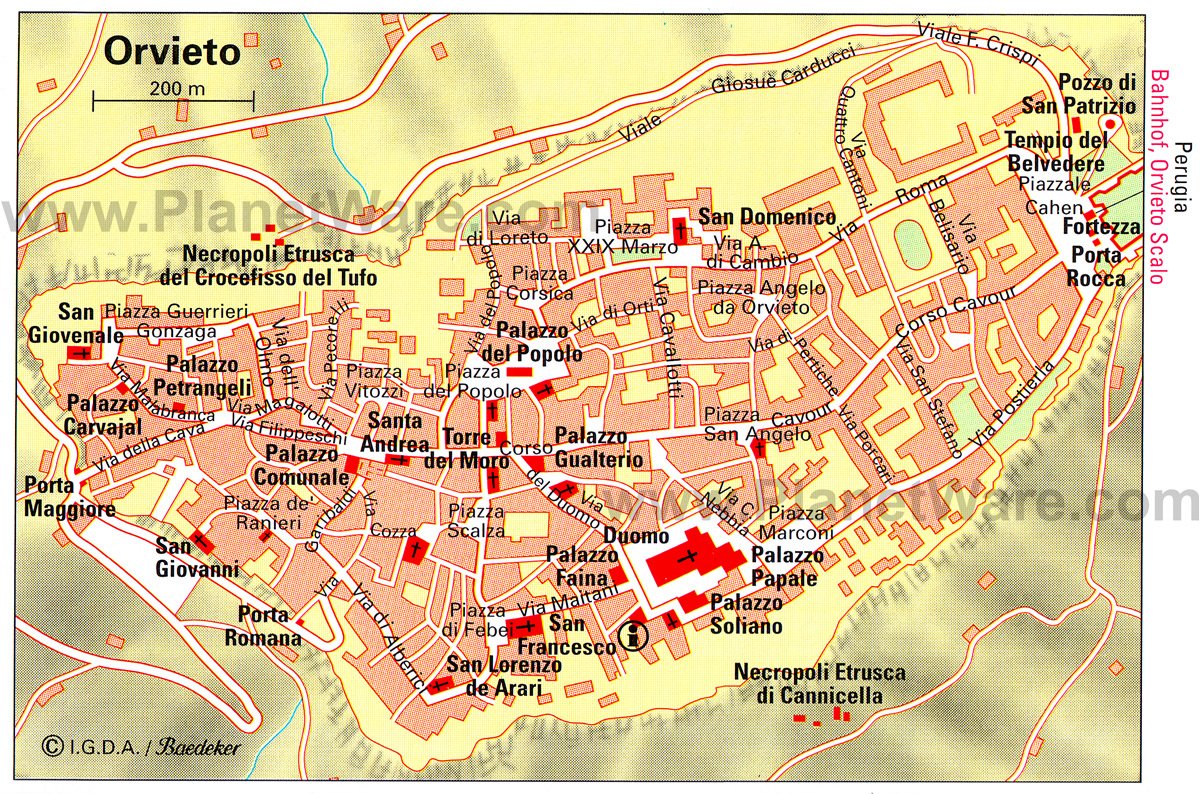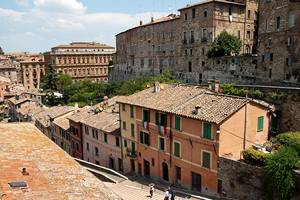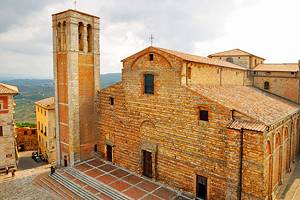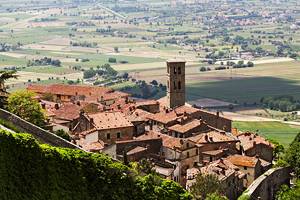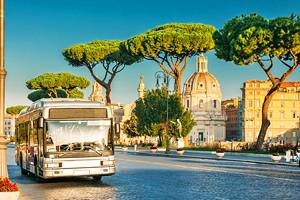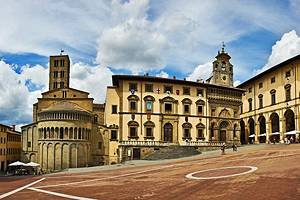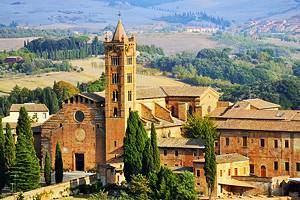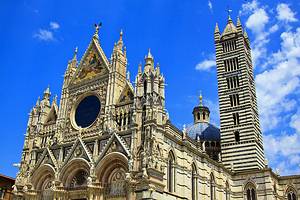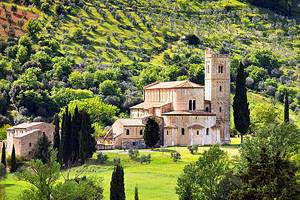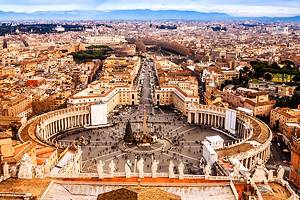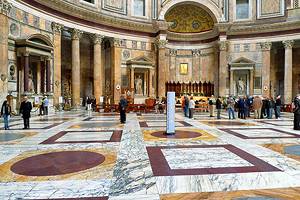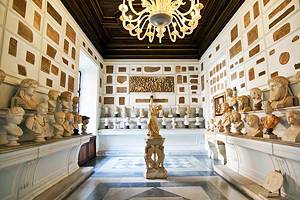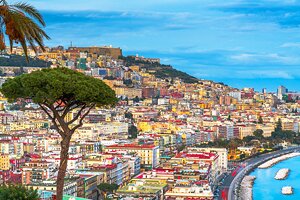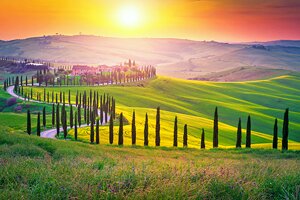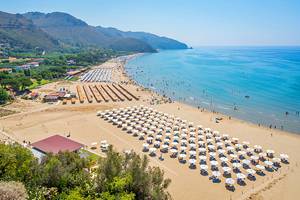Tourist Attractions in Orvieto
Only 100 kilometers north of Rome, the Umbrian town of Orvieto stands high above the Paglia valley on a crag of soft limestone called tufa. There are two distinct towns: the old high one and a newer one in the valley, where you'll arrive by train or park your car.
A funicular will whisk you up to the old town, where you'll find most of Orvieto's tourist attractions. Some of the most interesting of these lie underground, carved into the porous tufa since Etruscan times.
Orvieto's main street, Corso Cavour, traverses the town from east to west, and along it are some of the city's most interesting things to see. At its junction with Via del Duomo is the Torre del Moro; opposite stands the 16th-century Palazzo Gualterio, with a highly-decorated Late Renaissance doorway.
At its western end is busy Piazza della Repubblica, with a number of outstanding buildings. Beside the massive 12th-century Palazzo Comunale is the unusual tower of Sant'Andrea church. Showy Palazzo Ottaviani is now a bank headquarters.
Learn more about the best places to visit with our list of the top attractions and things to do in Orvieto.
Duomo di Orvieto (Cathedral)
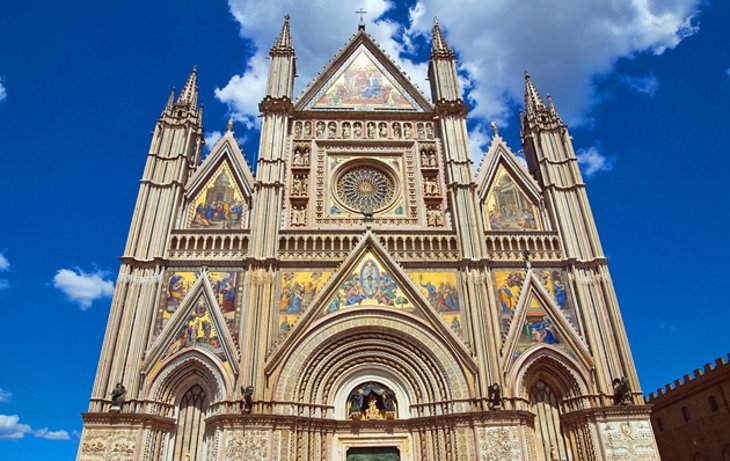
The city's top tourist destination is this striking church with its unusual façade, quite different from those you've seen elsewhere in Italy. It seems as though its interior decoration has been put on the outside - alternating courses of black basalt and yellow limestone were decorated by the finest artists of the day, covering every surface with sculptures, stained glass, and brightly colored mosaics.
But unlike most Italian churches with mosaics decorating their facades, this one is clearly and unmistakably Gothic in design, not Byzantine. It is, in fact, one of the most splendid examples of Italian Gothic architecture. The intricately cast modern bronze doors, completed in 1969, are by Emilio Greco.
The church was founded in 1290 in honor of the Miracle of Bolsena, an event that gave rise to the papal bull of 1264 that instituted the feast of Corpus Christi. During a mass in nearby Bolsena, blood issuing from a consecrated host stained the chalice cloth, which is now kept inside a gold reliquary behind the altar of the Cappella del Corporale.
The cathedral's highlight, though, is the Cappella del San Brizio, featuring Luca Signorelli's frescoes of the Judgment and Resurrection. Instead of using symbols to represent these themes, Signorelli told the stories through real people, with very human emotions and actions.
These are among the supreme achievements of 15th-century painting, and his humanistic approach inspired the younger but contemporary artist Michelangelo. Expect a wait to see these in busy seasons, as admission to the chapel is limited to a fixed number at a time.
Address: Piazza del Duomo, Orvieto
Pozzo di San Patrizio (St. Patrick's Well)
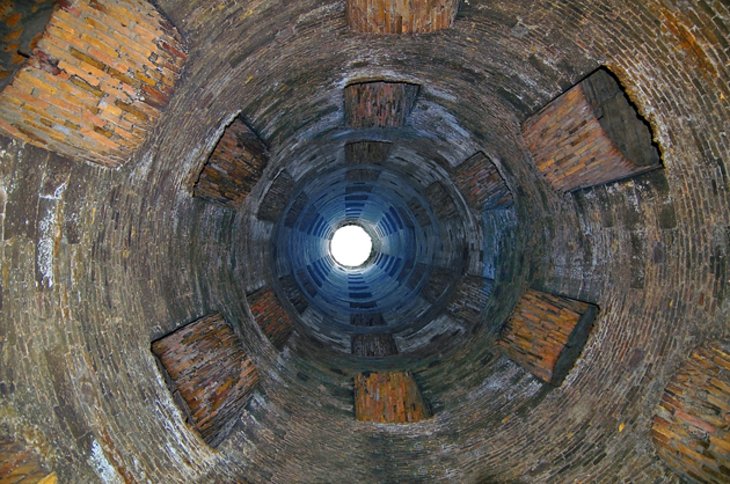
Beyond the Fortezza (now public gardens), the Pozzo di San Patrizio is a well, 61 meters deep with two separate spiral staircases winding around the shaft. One was built for the descent, and the other for the ascent of the donkeys that brought up water from the well, and the ingenious double-helix design allowed them to move in both directions continuously without collision.
In 1527 during the Sack of Rome, Pope Clement VII took refuge in Orvieto, commissioning the construction of the well to supply water in case of siege. You can descend the several hundred steps to its bottom. Not far from the well, along the green perimeter of the cliff, you can see the stairway; parts of the foundation; and columns of an ancient Etruscan temple, Tempio del Belvedere.
Address: Viale San Gallo, Orvieto
Orvieto Underground and Pozzo della Cava
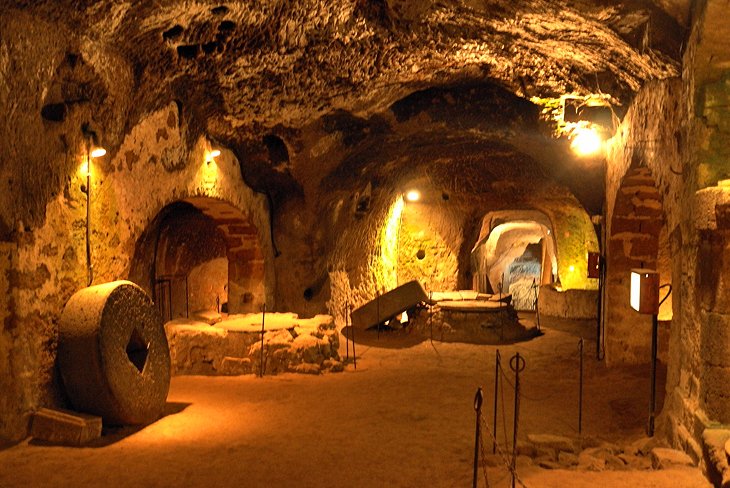
More than two millennia ago, ancient inhabitants began digging tunnels, passageways, and caves in the soft tufa rock the city is perched upon. Over succeeding centuries, streets, city gates, and rooms were carved from the rock; wells were dug; and tombs were carved into its passageways. Porta Maggiore, the oldest town gate, was hewn from the rock. Via della Cava runs through an atmospheric medieval quarter where you can tour underground rooms and a 36-meter-deep Etruscan well, Pozzo della Cava.
Hour-long underground tours guide you through parts of a multi-level maze beneath the city that is estimated to include more than 1,200 tunnels, caves, silos, and wells (get tickets at the Orvieto tourism office). Nearly every house has tunnels or cave rooms underneath it, and several are open to tours where you can see rooms, even Etruscan tombs, where artifacts discovered here show their use as workshops in the Middle Ages.
Torre del Moro
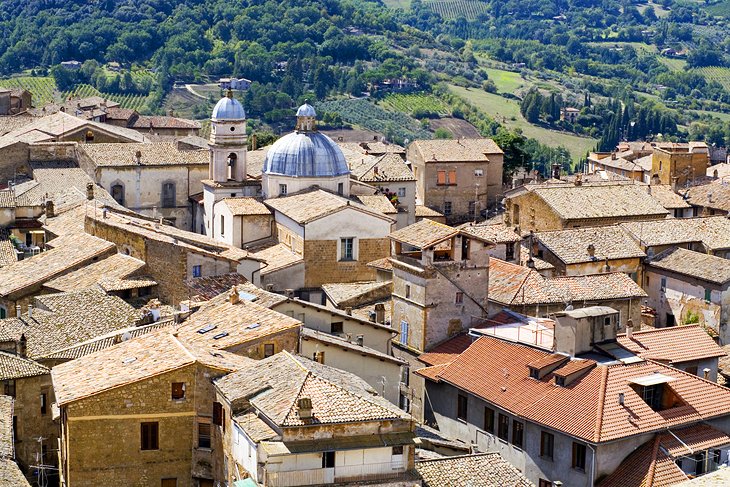
The quadrangular tower overlooking the heart of the old city is 40 meters tall and was built in the late 13th century to keep watch for possible invaders. In the 1800s, it became a cistern for the new aqueduct system; the clock was installed in 1876.
The 360-degree views from the observation deck are splendid; an elevator can take you about halfway, but you'll have to climb the rest of the stairs to the top. An inscription on the base of the Torre del Moro quotes Dante's Divine Comedy, referring to fights between the rival families of the Monaldeschi and Filippeschi in medieval Orvieto.
Address: Via Cavour, Orvieto
Etruscan Buildings and Necropolis
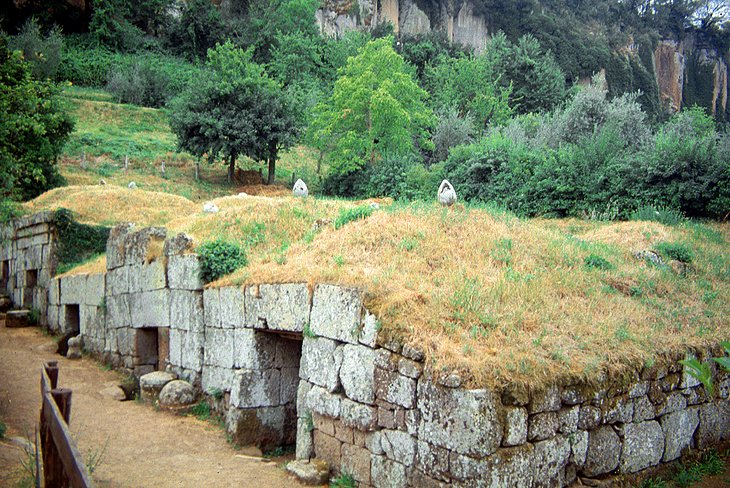
Near the Pozzo di San Patrizio are the remains of the Tempio Etrusco, and below the north side of town is an interesting Etruscan necropolis known as Tombe Etrusche del Crocifisso del Tufo. Most of the tombs date from the fifth and sixth centuries BC.
Another Etruscan necropolis known as the Tombe Etrusche di Cannicella lies to the south of town. Artifacts found in these tombs and others are displayed in the Palazzo Soliano and Palazzo Faina museums in Orvieto.
Museo Claudio Faina
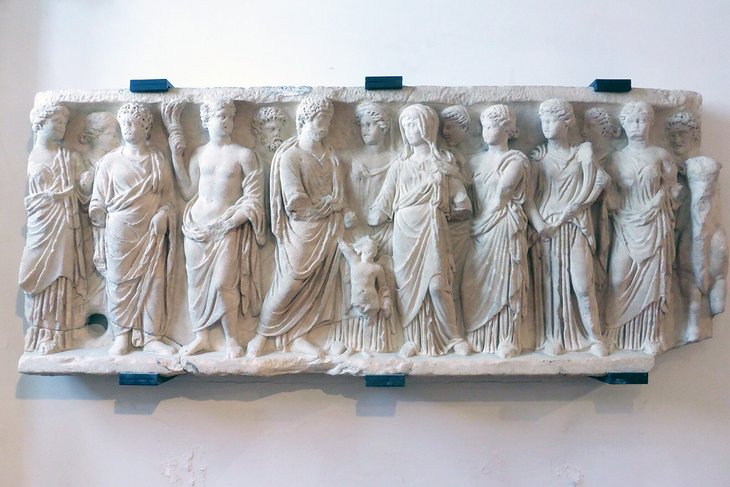
Opposite the cathedral, the Claudio Faina Museum contains one of Italy's most important collections of prehistoric and ancient finds, especially Etruscan figured pottery, bronzes, and jewelry. The more than 3,000 Roman coins are worthy of a museum of their own, and the collections of Attic black and red pottery and Etruscan pottery are equally outstanding.
Of particular importance are the unique amphorae made by Exekias, the most acclaimed ancient Greek potter and vase-painter, who worked in Athens in the mid-500s BC. These are made in the black-figure technique, with scenes painted onto the red clay base that became black when fired; the fine details were created by the sgraffito technique to reveal the base red clay. The artifacts and artworks in this museum were collected in the late 1800s from early excavations.
Another reason to visit this museum is for the excellent view of the mosaics on the Orvieto Cathedral. Take the elevator to the third floor to look directly across at the same level as the mosaics.
Address: Piazza del Duomo, Orvieto
Museo Archeologico Nazionale
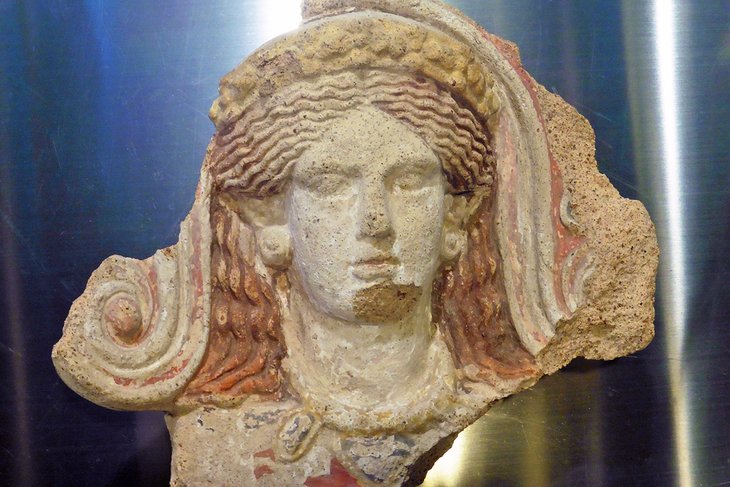
At the other side of the cathedral from Palazzo Faina is the 13th-century Palazzo Soliano, housing the National Archaeological Museum. It also displays Etruscan finds, but those discovered in more recent digs in the area.
Five rooms are filled with exquisite Etruscan pottery, metalwork, and stone carving, many from the Tombe Etrusche del Crocifisso del Tufo and from the more recently excavated Campo della Fiera archaeological site. Here, too, is a reconstruction of the two Golini tombs, discovered at the end of the 19th century.
Address: Piazza del Duomo, Orvieto
Chiesa di Sant'Andrea
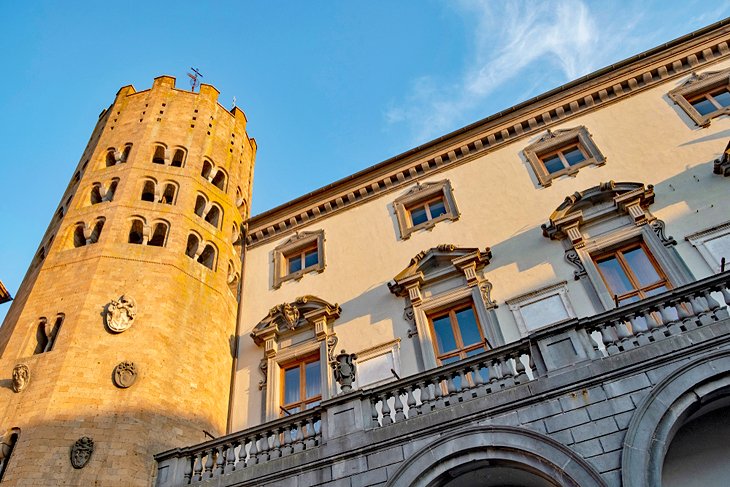
Next to the Palazzo Comunale, Chiesa di Sant'Andrea dates from the 12th century, but has been changed architecturally in the subsequent eras. Contemporary sculptures on the portal and the stained glass in the rose window are the results of the latest renovations.
Although the church was important in medieval times as the place where two popes were appointed, it is mainly interesting today for its unusual 12-sided bell tower and for the four different eras evident below the church.
The earliest are bronze-age ceramics and bronze artifacts discovered here, below the remains of an Etruscan road pavement. There are a few Roman ruins, topped by intricate mosaic floors in the shape of an early Christian church, perhaps the city's first. You can visit these remains with a guide.
Address: Piazza della Repubblica, Orvieto
Il Labirinto di Adriano
While renovating their bakery in the 1970s, the owners of this popular restaurant discovered a series of about 20 caves, silos, and passageways carved out of the tufa below, many dating to Etruscan times. They began to explore and preserve these long-hidden interconnected chambers, tanks, and tunnels, and invited an artist to decorate some portions of them with tufa sculptures.
Artifacts discovered in the restoration are displayed, and the guide explains how the ancient Etruscans mastered hydraulics to build wells and cisterns, some of which were coated inside with plaster sealant. You'll need a reservation to tour the caves.
Address: Via della Pace 26, Orvieto
Official site: https://www.labirintodiadriano.com/en/
Palazzo del Popolo
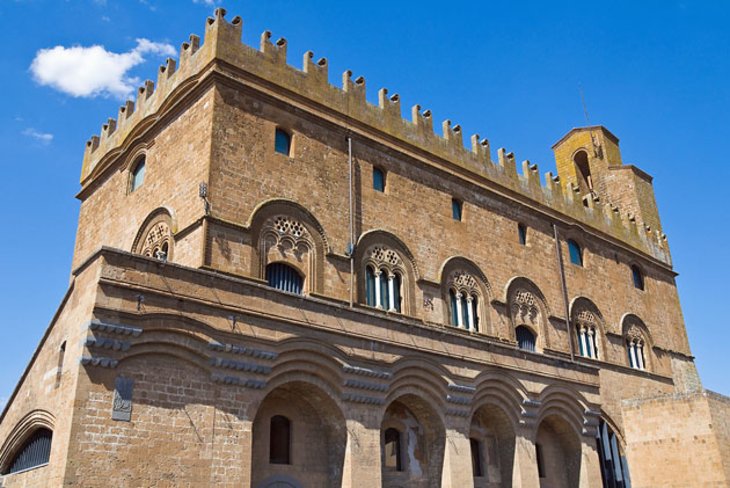
A short distance north of the Torre del Moro is the Piazza del Capitano del Popolo, where outdoor markets are held on Thursday and Saturday. The impressive crenellated facade of the 13th-century Palazzo del Popolo, built in volcanic tufa stone, is approached by a flight of steps. During the Middle Ages, this palace was the home of the Capitano del Popolo (Captain of the People), who represented the interests of the populace in dealing with ruling nobility.
Since then, it has served as a university of law and theology, a theater, and most recently as a conference center. You'll notice that several other buildings in Orvieto reflect some of the decorative elements of this palace, especially the elegant ground-floor arches and the window cornices. The delicate stonework in the windows is especially beautiful.
Address: Piazza del Capitano del Popolo, Orvieto
Fortezza dell'Albornoz
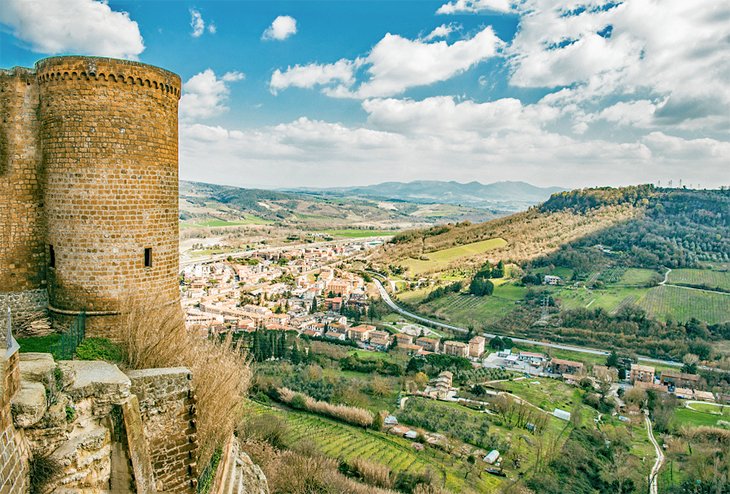
Standing on the site of an Etruscan temple, the fortress was built at the order of the Spanish Cardinal Albornoz, papal legate to Pope Innocent VI in the mid-1300s. Its purpose was to capitalize on the recent military victories in the region and secure the city for the church. It was almost completely destroyed later in the century and not rebuilt until the mid-1400s, this time with more protective fortification walls.
After the Sack of Rome in 1527 Pope Clement VII took refuge in the city and ordered the Pozzo di San Patrizio dug to assure a water supply in case of siege. Only the main tower and a part of the fortress remain today, surrounded by a lovely park and public garden, from which you'll find beautiful views across the valley.
Map of Attractions & Things to Do in Orvieto
Orvieto, Italy - Climate Chart
| Average minimum and maximum temperatures for Orvieto, Italy in °C | |||||||||||
| J | F | M | A | M | J | J | A | S | O | N | D |
| 10 1 | 11 2 | 14 3 | 17 5 | 21 9 | 25 12 | 29 15 | 29 15 | 25 13 | 20 9 | 14 5 | 10 2 |
| PlanetWare.com | |||||||||||
| Average monthly precipitation totals for Orvieto, Italy in mm. | |||||||||||
| 56 | 61 | 48 | 61 | 56 | 56 | 28 | 53 | 58 | 86 | 94 | 69 |
| Average minimum and maximum temperatures for Orvieto, Italy in °F | |||||||||||
| J | F | M | A | M | J | J | A | S | O | N | D |
| 49 33 | 51 35 | 56 37 | 61 41 | 70 47 | 77 53 | 84 58 | 84 59 | 77 55 | 67 48 | 57 40 | 50 35 |
| PlanetWare.com | |||||||||||
| Average monthly precipitation totals for Orvieto, Italy in inches. | |||||||||||
| 2.2 | 2.4 | 1.9 | 2.4 | 2.2 | 2.2 | 1.1 | 2.1 | 2.3 | 3.4 | 3.7 | 2.7 |
More Related Articles on PlanetWare.com
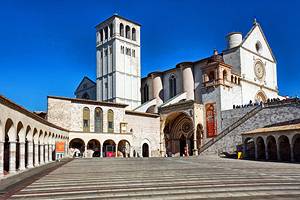
Exploring Umbria and Southern Tuscany: From Orvieto, it's easy to reach two other highlights of Umbria - Perugia and Assisi. You can be sure to discover all the sites related to St. Francis with the help of our page on the Tourist Attractions in Assisi. Northwest of Assisi, in Tuscany, you can visit the tourist attractions in Siena and the hilltop town of Montepulciano, both among the top places to visit in Tuscany.
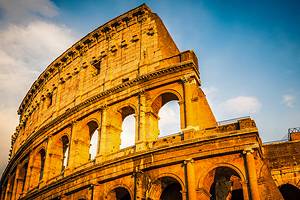
Seeing More of Italy: From Orvieto, it's only a one-hour train ride to Rome, where you can tour the Colosseum and marvel at the treasures of Vatican City. In less than two hours, you can be admiring the Renaissance art works in the Uffizi Gallery and other museums in Florence.
